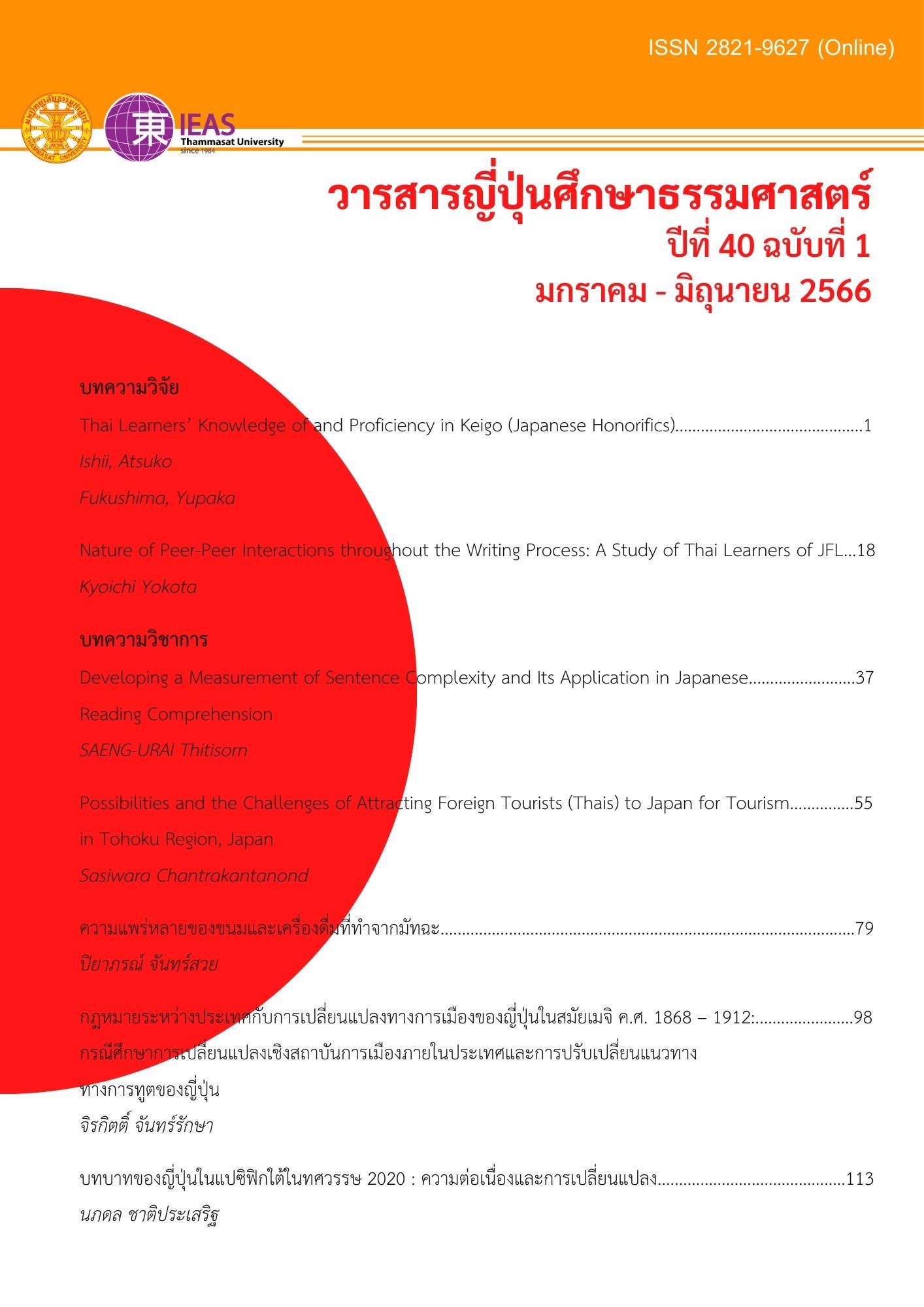Developing a Measurement of Sentence Complexity and Its Application in Japanese Reading Comprehension
Keywords:
Sentence structure, Reading comprehension, Bottom-up processing, Retelling, TranslationAbstract
This paper aimed to determine the complexity of Japanese sentences that are difficult for learners to understand by considering the factors that contribute to their complexity. Based on these factors, an index was developed to evaluate the complexity of sentences. The sentence complexity index was divided into two categories comprising a syntactic complexity index and a contextual complexity index, each of which can be summarized as follows. The syntactic complexity index consists of five indicators including (1) number of clauses, (2) number of dependent clauses, (3) number of phrases called Bunsetsu, (4) number of modifying components, and (5) number of components inside the predicate. The contextual complexity index consists of two indices including (1) number of indicatives and (2) number of abbreviated phrases. By evaluating Japanese sentences using these indices, the author believes it is possible to distinguish which sentences are difficult for learners to understand. Finally, a post-reading translation and retelling activity was suggested to assess the accuracy of the reading as well as the extent to which content that had already been read was retained in memory. The sentence complexity index presented in this paper is only a trial draft. It is believed that further improvement will be required in the future by utilizing this draft and modifying it as necessary.
Downloads
References
Davison, A., & Green, G. M. (1988). Linguistic Complexity and Text Comprehension: Readability Issues Reconsidered. Lawrence Erlbaum Associates.
Prashant, P. (2014, March 19). 日本語学 (Japanese Linguistics) /名詞修飾 (連体修飾) 表現 (Noun Modification (Additional Modification) Expressions). e-PG Pathshala. http://epgp.inflibnet.ac.in/Home/ViewSubject?catid=oGy0L4YuSB1wGMw4uhFqXw==(参照2022-01-03)
ポクロフスカ・オーリガ.(2019). 第1章 誤読の読解指導:誤読の仕組みとそれを減らすためのサポート 石黒圭(編), 日本語教師のための実践・読解指導, (pp. 12-29). くろしお出版
卯城裕司.(2014). 英語リーディングの科学―「読めたつもり」の謎を解く. 研究社.
橋亜紀子. (2015). 中級日本語学習者の文章理解における問題点. ヨーロッパ日本語教育, 20, 401-402.
熊谷正志.(2002). 指示詞「こ」「そ」「あ」の学習プランについて. 教授学の探究, 19, 139-160.
小河原義朗・木谷直之・熊谷智子. (2015). 読解授業における再話-学習者ペア活動の相互行為分析-. 小出記念日本語教育研究会論文集, 23, 5-17.
大石晴美.(2006). 脳科学からの第二言語習得論. 昭和堂
大槻美智子. (2012).「文の成分」を活かした品詞分類表試論. 教育研究, 38, 1-12.
町田健著.(2021). 日本語文法総解説. 研究社
陳志文.(2010). 連体修飾句における多重性と語順―中,上級読解の日本語教科書からの分析―. 台灣日本語文學報, 27, 175-193
田中伊式・李在鎬.(2018).「やさしい日本語ニュース」の難易度に関する学習者調査. 2018年度日本語教育学会秋季大会予稿集, 468-473.
藤原未雪.(2019). 第2章 語彙の読解指導:学習者の語の読み誤りから考える、語彙力をつけるための指導法 石黒圭(編) 日本語教師のための実践・読解指導. (pp.30-45).くろしお出版
日本語記述文法研究会(編). (2008). 現代日本語文法6 第11部 複文. くろしお出版
日本語記述文法研究会(編). (2009). 現代日本語文法7 第12部 談話, 第13部 待遇表現. くろしお出版.
日本語記述文法研究会(編). (2010). 現代日本語文法1 第1部 総論, 第2部 形態論. くろしお出版.
堀場裕紀江・松本順子. (2008). 文脈文の複雑さが文法項目の理解に及ぼす影響 ―母語背景の異なる第2言語学習者の比較から―. Scientific Approaches to Language, 7, 181-207.
野田尚史. (2019). 第3章 文法の読解指導 石黒圭 (編) 日本語教師のための実践・読解指導.(pp.46-64). くろしお出版.
野田尚史・桑原陽子・フォード丹羽順子・藤原未雪.(2014). 日本語学習者の読解過程―教師が考えているのとは違う学習者の実態―. ヨーロッパ日本語教育, 18, 37-38.
李在鎬.(2016).日本語教育のための文章難易度に関する研究. 早稲田日本語教育学, 21, 1-16.
尹盛熙. (2021). ことばの「省略」とは何か. 大修館書店
Downloads
Published
Issue
Section
License
Copyright (c) 2023 Thammasat Journal of Japanese Studies

This work is licensed under a Creative Commons Attribution-NonCommercial-NoDerivatives 4.0 International License.




